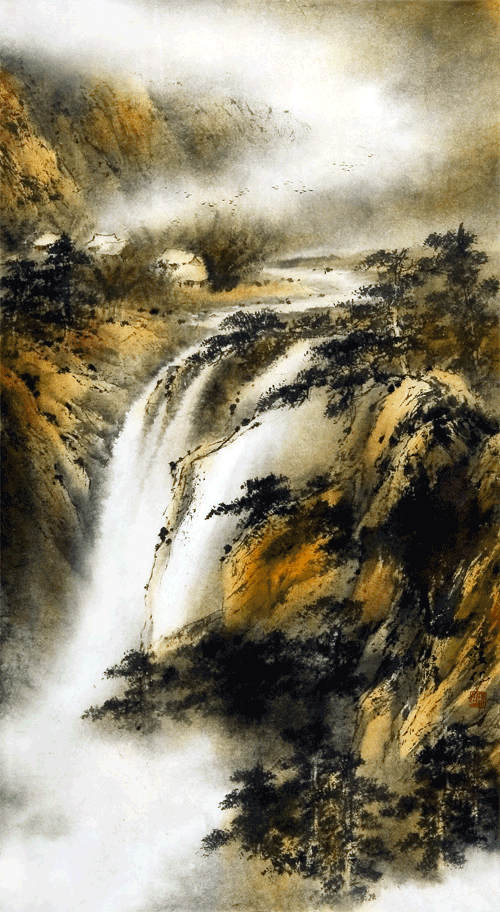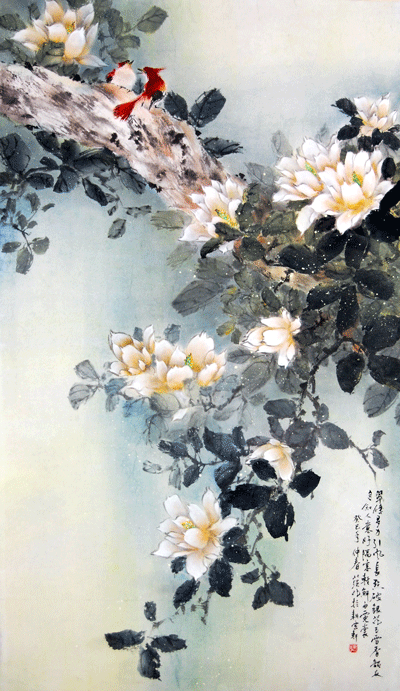|
|
|
SELECTED Articles | 0 | 1 | 2 | 3 | 4 |
BEYOND THE TRADITIONAL
Man Life & Style Feb. - Mar. 1989 BY KELLY CHOPARD
Critics from several countries and well-known Singapore Art Impresario, Delia Butcher, unanimously agree that he may one day be hailed as one of the finest Chinese brush painters of the century.
This distinction belongs to 37-year- old Singapore artist James Tan, an exponent of the Lingnan School of art. It has been said many times that he has perfected the technique of venturing beyond the traditional yet keeping the valued technique of the brush strokes in traditional Chinese paintings.
The Lingnan School is characterized by being freer than traditional Chinese painting. It allows the artist to infuse his own feelings, interpretation of subject-matter and emotions into the painting. It does not demand a dogmatic approach in terms of technique or style.
Because of this one can trace the growth of the artist, notice his mood at a particular period and study the influences he has been exposed to as the years pass.
Like Western art, it encourages the artist to interpret the subject in his own way. Unlike the traditional Chinese school, which leaves the background white, Lingnan artists wash the back-ground to create a mood. Another difference is that it relies less on brush-work and so permits the artist freedom to explore, create and innovate.
The Lingnan School developed in southern China shortly after the Qing dynasty came to an end in 1911. The initiators of this movement were "three Masters" who were art graduates from Japan. They lived in a period of revolutionary fervors set ablaze by Dr Sun Yat-Sen when the influx of western thought and culture was at its height. It is there-fore not surprising that changes took place in the artistic field
Lingnan art is a marriage between East and West. It employs traditional Chinese brushwork, combines this with western artistic techniques and incorporate-rates some elements from the Geshan school of Japanese art.
It was born in an area in the Guang-dong province and it was some time be-fore traditional artists accepted this revolutionary style.
Today paintings done in the Lingnan style are appreciated and much-sought after not only by Chinese art lovers but by art enthusiasts everywhere. James Tan finds that anyone can identify with Lingnan art because it in-corporate both worlds and can there-fore fit into any decor.
Then in 1973 he got his big break. He met a Chinese artist living in the States who invited him over to be his helper. James suddenly found himself painting furiously to forget how home-sick he was.
Loneliness seemed to pay off as he had enough paintings to participate in exhibitions in a country that was becoming increasingly interested in China. The exposure was good and James found himself even teaching art.
I recently met one of his former pupils from the States, Florence Spiering, a charming grey-haired matron visiting Singapore who said, "I used to travel 60 miles once a week for my art lessons. I wasn't the only one. All sorts of people came including bankers, businessmen and ladies of leisure. People were fascinated by the number of paintings James produced and wondered at how he found time to teach as well. We loved his art and we loved learning from him."
Apparently it's no different now that he's back in Singapore. He manages to combine paining, me business 01 selling his work, traveling abroad to make exhibition arrangements and teach be-tween 60-80 pupils.
Despite this, James still finds time to help the less fortunate. Recently he did 10 special paintings for the National Kidney Foundation which were reproduced into lunar New Year cards. The first thing you notice when you realistic and exude a feeling of serenity. Colours are muted yet fresh. Another trademark is that a subject is never alone in a scenic setting. This apparently reflects the artist's philosophy.
"I feel that to really appreciate beauty one must share it with someone, that's why I guess I tend to project this in my work," he mused. A prolific artist needs to expose him-self to the world in order to get ideas and inspiration.
"I visit beautiful places because when I see beauty I drink it in and somehow they find their way into the paintings," he explained. Looking at the multitude of finished, partly completed and framed paintings is mind boggling. One wonders how one person can produce so much so fast, without sacrificing quality.
"Oh I am very strict about quality. I destroy anything that is not good," James assured me with a laugh, pointing to a huge basket of discards.
At a recent exhibition I viewed over 100 paintings and marveled at his ability to portray action in his work. Fishes appear to swim, birds seem to glide, rivers wind their way lazily down gentle mountain slopes. People when present seem, like us, to view the captivating scene be-fore them.
This ability, says James, comes from studying nature and man carefully. One would say that his mind's eye is almost a camera. He is able to paint an evocative picture in words. His description of the awesome Himalayas, the wonders of the Grand Canyon, the view from the Great Wall and cherry blossom time in Japan make us almost 'see' the scene so it's understandable that he is able to put these mind pictures on paper so realistically.
If one were to analyze the reason for James' success one would say that his art has a basic universal appeal. It is an honest representation of life. There is no pretension. It is easily understood and visually pleasing.
The paintings are a comfortable blend of East and West. He has managed to evolve a style that is contemporary yet elements of traditional Chinese in-fluencies are always present. If I were asked to describe the work of James Tan in one word, that word would be harmony.
But the artist himself is not satisfied. He admits that he is continuously experimenting. "The Lingnan style allows me to improvise so I keep trying to achieve the ultimate," he said.
The title of a catalogue from a recent one man exhibition best describes James' quest. The Search for Inspiration.
| BIOGRAPHY | ARTICLES | GALLERY | EVENTS | RECENT WORKS | ART COURSE |
|

 He
has participated in 32 art exhibitions, 13 of which were one-man shows.
His works are exhibited in several countries and found in museum
collections and government organizations. Hotels and banks have
commissioned him to do work for them. Topping the list of this
extraordinary man achievements is probably the Glass Hotel in Singapore
which ordered 1,000 paintings. Even the Emir of oil-rich Bahrain owns an
original in his private collection.
He
has participated in 32 art exhibitions, 13 of which were one-man shows.
His works are exhibited in several countries and found in museum
collections and government organizations. Hotels and banks have
commissioned him to do work for them. Topping the list of this
extraordinary man achievements is probably the Glass Hotel in Singapore
which ordered 1,000 paintings. Even the Emir of oil-rich Bahrain owns an
original in his private collection.  James Tan after graduating from the Singapore Academy of Art took a
correspondence course in painting from the famed master of the Lingnan
School. Professor Au Ho-Nine. "It wasn't easy. Each month he sent me eight
samples of art to copy, with instructions like, first you paint the
branches, then the flowers, followed by the birds," James recalled.
James Tan after graduating from the Singapore Academy of Art took a
correspondence course in painting from the famed master of the Lingnan
School. Professor Au Ho-Nine. "It wasn't easy. Each month he sent me eight
samples of art to copy, with instructions like, first you paint the
branches, then the flowers, followed by the birds," James recalled.



